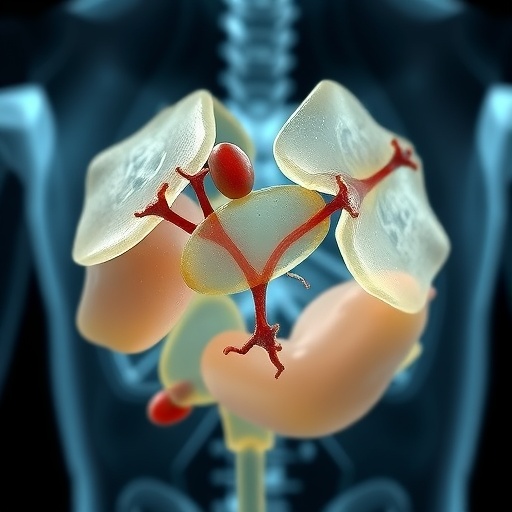Research in the field of metabolic disorders is continuously evolving, bringing new insights that can better inform healthcare practices. A recent study by El-Sehrawy, Alshkarchy, and Kareem has shed light on an intriguing correlation involving serum uric acid to creatinine ratio and metabolic profiles in individuals afflicted with non-alcoholic fatty liver disease (NAFLD). This research provides significant data that could potentially alter how clinicians approach treatment and diagnosis in cases of this prevalent disease, which is increasingly recognized as a global health concern.
NAFLD is characterized by the accumulation of fat in liver cells, independent of alcohol consumption. With increasing rates of obesity and metabolic syndrome worldwide, NAFLD has become one of the most common liver diseases. Its association with various metabolic risk factors, including insulin resistance, dyslipidemia, and hypertension, underscores the importance of understanding the underlying mechanisms that drive this condition. The implications of this study extend beyond mere academic curiosity; they touch on pressing public health issues that require immediate attention.
The researchers aimed to elucidate the relationship between serum uric acid—a product of purine metabolism—and creatinine, a byproduct of muscle metabolism, particularly in the context of metabolic disturbances associated with NAFLD. Their hypothesis was built upon existing literature that has suggested an intriguing connection between elevated levels of uric acid and various metabolic disorders, including obesity and type 2 diabetes, both of which are closely associated with NAFLD. By investigating this relationship, the researchers strived to identify potential biomarkers that could aid in the early detection and management of this liver disease.
Utilizing a sample of patients diagnosed with NAFLD, the researchers conducted a comprehensive analysis to evaluate the serum uric acid to creatinine ratio. The focus on this ratio is particularly compelling, as it offers a nuanced view of renal function alongside metabolic health. Elevated uric acid has long been regarded as an independent risk factor for metabolic syndrome and may complicate the clinical picture of NAFLD due to its role in inflammation and oxidative stress, both of which are key pathological features of the disease.
Findings from the study indicated a significant association between higher serum uric acid to creatinine ratios and adverse metabolic profiles in individuals suffering from NAFLD. As such, the data suggest that this biomarker could serve as a valuable tool in identifying patients at higher risk for severe liver disease and associated metabolic complications. This correlation also opens new avenues for therapeutic interventions that target uric acid levels, potentially offering new hope for better treatment outcomes.
Moreover, the distinction between serum uric acid and creatinine levels emphasizes the importance of integrating multiple biomarkers into the assessment of NAFLD. Clinicians often rely heavily on traditional liver enzyme tests; however, the findings from this study encourage a more holistic approach that considers a broader panel of metabolic indicators. By understanding the interconnectedness of these biomarkers, healthcare providers can enhance their diagnostic accuracy and make more informed decisions regarding treatment strategies.
The implications of such research extend beyond the individual patient, potentially influencing public health policies and healthcare systems as a whole. With NAFLD projected to rise significantly, awareness of its metabolic implications can drive healthcare initiatives aimed at preventing this condition. Education about dietary choices, lifestyle changes, and clinical assessments can help curb the rising tide of NAFLD, aligning with global initiatives to reduce the burden of liver disease.
Ultimately, increased collaboration between researchers, healthcare providers, and policymakers is essential to address the growing challenges posed by NAFLD and its associated metabolic risks. By effectively translating such research findings into clinical practice, we can improve early detection rates and develop individualized treatment plans that cater to the unique metabolic profiles of patients. This integrative approach may not only enhance patient outcomes but also contribute to a more sustainable healthcare system focused on proactive management.
As research continues to unveil more about the pathophysiology of NAFLD and its relationship with metabolic disorders, the development of innovative diagnostic tools could soon become a reality. Emerging technologies in genomics, proteomics, and metabolomics promise to provide deeper insights into individual patient profiles. Consequently, the potential for personalized medicine in treating NAFLD could position clinicians to offer targeted therapies that address the root causes of the disease, rather than merely its symptoms.
In summary, the association between serum uric acid to creatinine ratio and metabolic profile in individuals with NAFLD presented in the study by El-Sehrawy and colleagues is a crucial step toward the refinement of diagnostic practices and treatment modalities. When clinical practice aligns closely with current research, patients are likely to benefit from enhanced evaluation strategies that consider a comprehensive view of health. As metabolic disorders such as NAFLD continue to increase in prevalence, prioritizing research and its application will be pivotal in shaping the future of liver health management.
In conclusion, the findings of this research spark a crucial dialogue about the need for innovative approaches and rigorous scientific inquiry into NAFLD and its complex interactions with metabolic parameters. The implications of these discoveries could resonate throughout the healthcare community, impacting how we understand, diagnose, and treat this increasingly prevalent condition. Moving forward, the integration of new evidence with clinical applications will pave the way for better healthcare strategies and improved outcomes for thousands of individuals affected by NAFLD.
Subject of Research: The association between serum uric acid to creatinine ratio and metabolic profile in individuals with non-alcoholic fatty liver disease (NAFLD).
Article Title: Association between serum uric acid to creatinine ratio with metabolic profile in subjects with non-alcoholic fatty liver disease (NAFLD).
Article References:
El-Sehrawy, A.A.M.A., Alshkarchy, S.S., Kareem, A.K. et al. Association between serum uric acid to creatinine ratio with metabolic profile in subjects with non-alcoholic fatty liver disease (NAFLD).
BMC Endocr Disord 25, 260 (2025). https://doi.org/10.1186/s12902-025-02074-0
Image Credits: AI Generated
DOI: https://doi.org/10.1186/s12902-025-02074-0
Keywords: NAFLD, serum uric acid, creatinine, metabolic profile, liver disease, biomarkers, public health.




